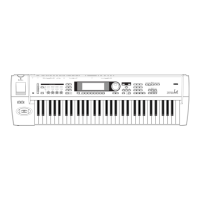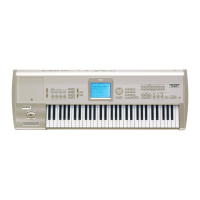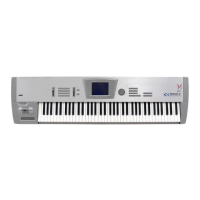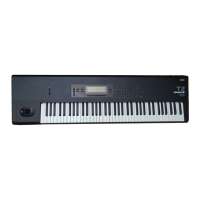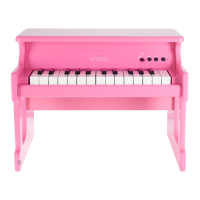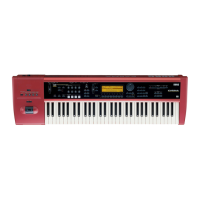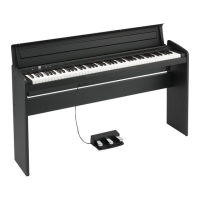61
Basic functions
Sequencer mode
Sequencer mode
This instrument contains a 16-multi track MIDI
sequencer. The sequencer is the center to which
TRITON Le’s numerous functions are integrated,
allowing it to be used in a variety of situations includ-
ing music production and live performance.
When you turn off the power, the settings made in
Sequencer mode and the song data, cue list data,
and user pattern data that you recorded are not
backed up. If you wish to keep this data, you must
save it on external media (SmartMedia etc.) before
turning off the power, or perform a MIDI data
dump to save the data on an external data filer etc.
If you wish to save the programs, track parame-
ters, effects, and arpeggiator function settings etc.
selected for a song as a template song, use the Util-
ity menu command “Save Template Song.”
Immediately after the power is turned on, this
instrument will not contain any cue list data or
song data, so if you wish to playback a song on the
sequencer, you must first load data from external
media (SmartMedia etc.) or receive a MIDI data
dump from an external MIDI sequencer (
☞p.41,
97, PG p.143)
Features of the sequencer
• The sequencer lets you record a maximum of
200,000 events (note data etc.), up to 200 songs, and
as many as 999 measures per song.
• Up to 20 cue lists can be created.
A cue list is an arrangement of up to 99 songs that
will be played as a chain. You can specify the num-
ber of times that each song will repeat. Songs in a
cue list can also be converted into a single song.
• The arpeggiator function can be used for playback
or recording.
• The RPPR (Realtime Pattern Play/Recording)
function can be used for playback or recording.
• Sixteen different template songs are built-in, and
contain program and effect settings suitable for
various musical styles. Up to sixteen original
templates that you create can be saved as user
template songs.
• One stereo insertion effect, two master effects,
and a stereo master EQ can be used for each song.
• Timing resolution is a maximum of /192.
• Sixteen tracks are provided for musical data, and a
master track contains time signature and tempo
data that controls the playback.
•A track play loop function lets you loop specified
measures independently for each track.
• 150 preset patterns ideal for drum tracks are built
in. In addition, you can create up to 100 user
patterns for each song. These patterns can be used
as musical data within a song, or can be played by
the RPPR function.
• Various methods of recording are supported,
including realtime recording in which your
performance on the keyboard and controllers
(including MIDI control events) is recorded just as
you play, and step recording in which the timing,
length, and velocity of each note can be specify in
the LCD as you input the pitches from the
keyboard.
• The musical data and control events that you
recorded can be edited in various ways (including
event editing and many other edit commands).
• When the “Status” of a track is set to INT or BTH,
an external sequencer can be used to play this
instrument as a multi-timbral tone generator.
When the “Status” of a track is set to BTH, EXT, or
EXT2, the sequencer of this instrument can play
external tone generators.
• Playback can be synchronized with an external
MIDI device.
• This instrument’s AMS (Alternate Modulation)
capability lets you use control changes for realtime
control of the parameters of the programs used in a
program. Its MIDI Sync. functionality lets you
synchronize the LFO speed to changes in the tempo.
• Dmod (Dynamic Modulation) functionality lets
you control effect parameters in realtime. You can
also use MIDI Sync. to synchronize the LFO speed
or delay time to changes in the tempo.
• You can assign names not only to the song, but also
to each pattern and track.
• Combination settings can be copied to a song.
• Sequencer data such as a song or cue list that you
create can be saved in this instrument’s native
format, or transmitted as a MIDI data dump.
•A song you created can be converted into SMF
(Standard MIDI File) data. SMF songs can also be
loaded.
• The PLAY/MUTE/REC and “SOLO On/Off” let
you instantly play/mute any desired track.
• You can rewind or fast-forward while listening to
the sound.
• The [LOCATE] key lets you move quickly to a
desired location.
• If the EXB-SMPL (sold separately)option is
installed, multisamples you create can be played in
Sequencer mode together with the internal
programs.
The Time Slice function of Sampling mode lets you
divide a rhythm loop sample and create perfor-
mance data that corresponds to the divided sam-
ples. In Sequencer mode you can play this
performance data, and adjust the playback tempo
without affecting the pitch of the rhythm loop sam-
ple. You can also exchange the note numbers of the
data, or modify the timing to freely re-create the
original rhythm loop.
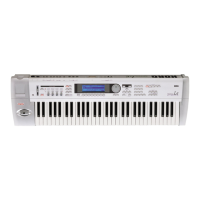
